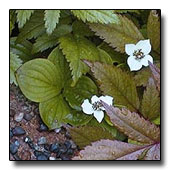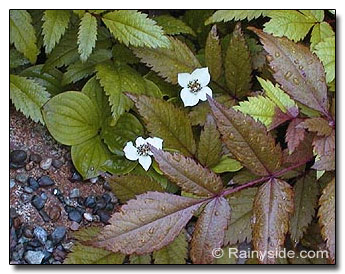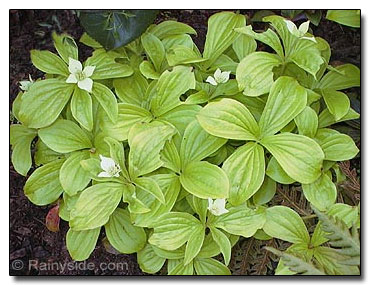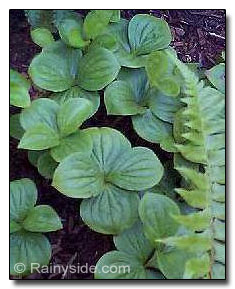Cornus unalashkensis
BUNCHBERRY, CREEPING DOGWOOD
syn. Cornus canadensis
Family: Cornaceae
Pronounced: KOR-nus kan-a-DEN-sis

Quick Jumps
Growing Guide
Rainy Side Notes
GROWING GUIDE

Origin:
North America, North Asia, Greenland.
Plant Group:
Sub shrub.
Hardiness:
Sunset zones: 1-7, 8, 9, 14-16.
USDA zones: 2-7.
Mature size:
Height: 6 inches (15 cm).
Width: Indefinite.
Flowering period:
Late spring to early summer.
Flowering attributes:
Green flowers surrounded by showy greenish white, sometimes pink flushed, bracts.
Leaf attributes:
Whorls of green leaves that remain evergreen in most of the Pacific Northwest maritime climate.
Growth habit:
Creeping subshrub.
Light:
Shade, dappled shade or partial shade with morning sun.
Soil:
Moist, acidic, humus rich soil.
Propagation Methods:
Sow seed and provide cold stratification for 60-90 days at 41°F. Continue in warm conditions until germination occurs.
Divide in spring or fall.
Cuttings in spring.
Pests and Diseases:
No serious problems.
Rainy Side Notes


Local, Pacific Northwest indigenous people found many uses for the plant and berries of Cornus unalashkensis. The Makah ate the berries fresh and called them bubukwak!tibupt, which means berries with pebbles in them. The Quinault thought the fruit was poisonous and called them olka’stap, which means snake berry. The Hoh and Quileute used the berries in ceremonies and used the bark as a tonic. Both tribes dried the leaves and smoked them.
In modern times bunchberry is used for several medicinal (see disclaimer*) purposes. Used in place of aspirin, it helps decrease inflammation; without stomach problems from aspirin. Bunchberry is consumed as a tea for fevers and chills and colitis, dysentery, diarrhea and gastritis. The mild herb is sometimes preferred over harsher remedies.
This little ground cover can be challenging to establish, but once entrenched in the garden, it thrives in partial shade to full shade conditions. Mine grow in the shadow of vine maple. Bunchberries struggle in clay soil without amendments; it needs the beneficial fungus that breaks down wood to thrive. I have success establishing the plants by throwing rotted wood chips or pieces of rotting wood in the planting hole and mulching with shredded bark mulch. Add additional compost and or bark mulch every other year. Although bunchberry spreads wide by underground runners, it is slow in doing so.
Dogwood-Raspberry Syrup:
2 cups of bunchberries (Cornus unalashkensis)
2 cups raspberries
¼-cup honey
4 tablespoons water
Place all ingredients in a saucepan. On medium heat, cook until berries are soft. Press fruit through a colander.
Syrup should be stored in a refrigerator. Use on pancakes, crepes or waffles.
Photographed in author's garden.

Gardening for the Homebrewer: Grow and Process Plants for Making Beer, Wine, Gruit, Cider, Perry, and More
By co-authors Debbie Teashon (Rainy Side Gardeners) and Wendy Tweton
Copyright Notice | Home | Search | Natives

